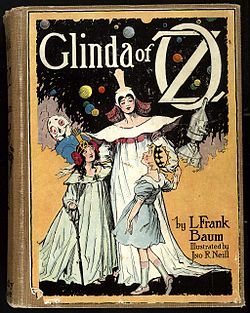 First edition cover | |
| Author | L. Frank Baum (posthumously) |
|---|---|
| Illustrator | John R. Neill |
| Language | English |
| Series | Oz books |
| Genre | Children's novel |
| Publisher | Reilly & Lee |
Publication date | July 10, 1920 |
| Publication place | United States |
| Media type | Print (hardcover) |
| Pages | 279 pp (first edition, hardcover) |
| Preceded by | The Magic of Oz |
| Followed by | The Royal Book of Oz |
| Text | Glinda of Oz at Wikisource |
Glinda of Oz is the fourteenth book in the Oz series written by children's author L. Frank Baum, published on July 10, 1920. It is the last book of the original Oz series, which, following Baum's death, was continued by other authors.